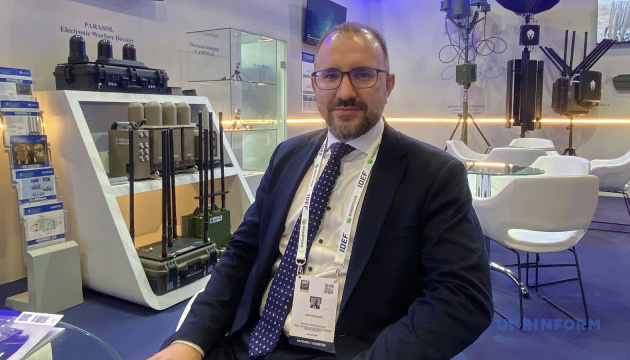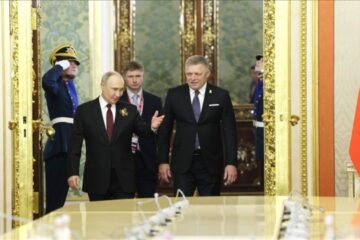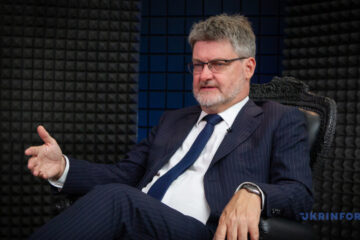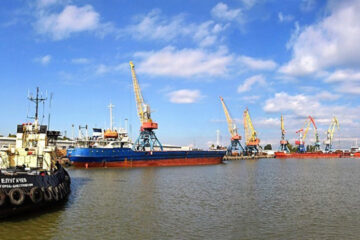The self-propelled gun system Bohdana, new armored vehicles, battle-tested drones, ground robotic platforms, as well as ammunition for unmanned platforms were on view among other new products at the international defense expo IDEF-2025 held on July 22 to 27 in Istanbul, Turkey. National Association of Ukrainian Defense Industries (NAUDI) exhibited products from 18 companies within a single national pavilion. The association unites over a hundred Ukrainian defense industries, promoting their products both on the domestic and global arms markets. Serhiy Honcharov, NAUDI Executive Director spoke in an interview with Ukrinform about the accomplishments achieved by Ukraine’s defense industrial sector, relevant requirements of frontline forces, and the strategy for further development, as well as cooperation with foreign partners amid full-scale war.
ON VIEW AT OUR BOOTHS IS EVERYTHING THAT HAS BEEN TESTED ON THE BATTLEFIELD AND COUNTERED BY ENEMY ELECTRONIC WARFARE COUNTERMEASURES
– Mr. Serhiy, against the backdrop of this vast array of products from companies from around the globe, what general trends in the development of defense industries can be observed?
– The global defense industry is moving towards everything unmanned. This is one of the main trends. Exhibited at IDEF-2025 is a huge array of unmanned vehicles for ground, air, and maritime missions. Consequently, we believe drone control to be the most relevant issue, including technologies for controlling drone swarms and, of course, anti-drone technologies. The second trend is a consequence of the first one – manufacturers of weapons and ammunition for drones are growing in numbers very rapidly. And Ukraine is at the forefront of this trend. While at the booths of some manufacturers we see nice concepts, designs that are beautiful, but not working very well in real life. On view at our booths is everything that has passed the test on the battlefield saturated with electronic warfare interference. We set the pace in this trend.
Our booth features manufacturers of unmanned aerial vehicles, ground robotic platforms, ammunition and weapons for use with unmanned platforms. In particular, these are the companies Ukrainian Armor with its new unmanned ground vehicle UGV Protector that has already been codified and approved for operational use by the Ministry of Defense of Ukraine, the UAV manufacturers Athlon-Avia and Jupiter-Drone, the manufacturers of anti-drone EW and SIGINT equipment Kvertus and Parasol, as well as UBM and Defence Solutions – the manufacturers of UAV munitions.
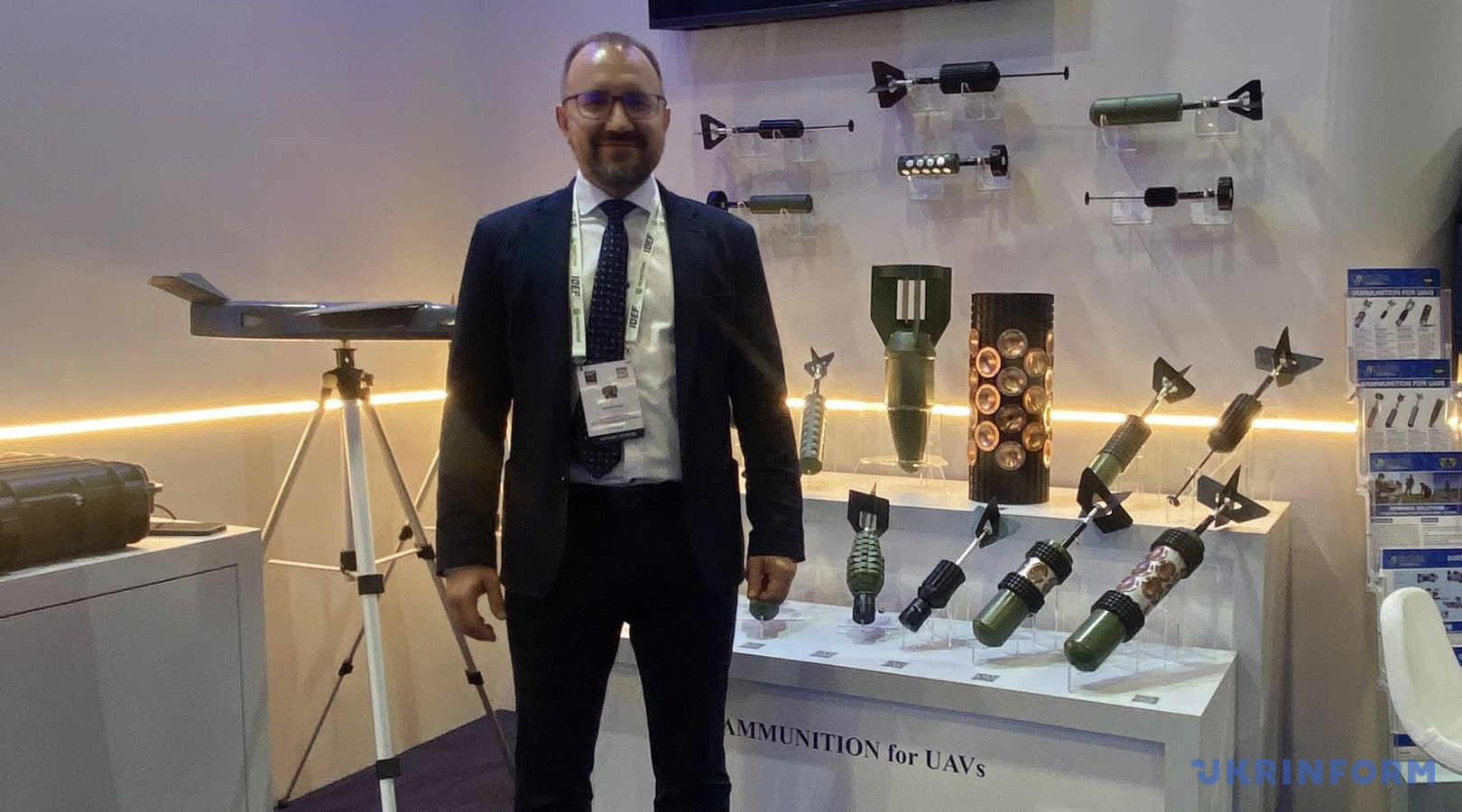
SELF-PROPELLED HOWITZER BOHDANA WAS CERTAINLY A SPECIAL THRILL OF THE UKRAINIAN DISPLAY
– What was the central attraction of foreign visitors to the NAUDI booth?
– This was certainly Bohdana – the first self-propelled howitzer designed and manufactured domestically in Ukraine. Currently, some three dozen Bohdanas are manufactured every month, which exceeds the monthly output of nearly each of foreign manufacturers of self-propelled howitzers. Additionally, a towed version (tailored for specific tactical missions) was designed, developed and brought into production within an extremely tight time frame. Initially, it raised eyebrows and a question as to the feasibility of using a towed version of the howitzer on the battlefield in 2025 alongside self-propelled original. However, the war that is currently underway is a kind of mix of the experiences of the First, Second and Third World Wars with extremely well developed engineering fortifications and 5-6 meter high trenches covered with caponiers, where the requirement for towed artillery is as high as for robotic platforms or drones for all purposes (from microdrones to heavy missile carriers). The Bohdana demonstrates efficiency, reliability, accuracy. Ukraine is able to produce hundreds of such vehicles per year. We have something to show a foreign customer, something to be proud of.
DEFENSE COOPERATION BETWEEN UKRAINE AND TURKEY AIMS TO BOLSTER SECURITY IN THE BLACK SEA REGION
– What expo displays captured your attention most?
– I cannot comment in detail on what is of interest to us or what is required. Quite obviously, there is a requirement for ballistic missiles, cruise missiles, and for air defense systems to shoot down all enemy targets. We also have a very strong dependence on chemical products, that is, gunpowder and explosives. These products are not produced in Ukraine. Those used in artillery shells are quite complex chemical compounds, and the range of manufacturers is limited. These are in short supply in Ukraine and elsewhere. Sooner or later, it becomes clear that no one has enough of everything, that everyone needs to significantly replenish their stockpiles.
And I would also like to note that Turkey’s accomplishments are striking indeed. Over the past two decades, Turkey has evolved into a major market for defense exports and a prominent player on the global arms market with its advanced technologies, generous government defense procurement contracts, proactive companies, and an understanding of market requirements. Historically, Turkish companies are our partners, and in the future, we are expecting a great number of projects for collaborations that will bolster Ukraine’s defense capabilities while simultaneously strengthening defense capabilities of Turkey. That country is an important player in the Black Sea region, and the security of this region is a common interest and goal for Ukraine and Turkey. And defense-industrial cooperation effectively contributes to this endeavor.
– What is the main message Ukrainian exhibitors at IDEF-25 want to bring across?
– Our main message is: the Ukrainian defense-industrial sector does exist, it is powerful, dynamically developing, and our enterprises are ready to be reliable partners for both state customers and defense-industrial enterprises from partner countries. We are ready and willing to collaborate in design and development projects, ready to share our accomplishments, knowledge, solutions. We are open to cooperation. Our goal remains unchanged: this is ensuring the maximum safety of the lives of military personnel, in particular, by using unmanned or robotic platforms to the maximum extent possible, for missions ranging from intelligence gathering and reconnaissance to logistics and engaging targets with various types of UAVs.
DEFENSE EXPORTS WILL STIMULATE DEFENSE INDUSTRIES TO GROW AND MODERNIZE
– At previous exhibitions, representatives of Ukrainian companies complained that the export ban negatively affects the industry’s development. How is this going today?
– The President of Ukraine announced that we are actually starting to open up exports, and Ukraine’s parliament, the Verkhovna Rada gave a first-reading vote to a package of bills on Defense City, which, among other things, is going to facilitate our expansion into new markets. It is crucial because there is still lot of untapped potential in Ukrainian defense industries, with only about 30 percent of their total capacity being used. As a result, we cannot be 100 percent effective and efficient with this potential not being used to its full capacity. Achieving maximum possible efficiency is about reducing production cost and about greater investment in R&D, including the design, development and testing of new defense products. Exports can be a good incentive to increase, modernize, and renew production after Russian attacks. Our partners have a vested interest in establishing co-production partnerships in Ukraine or on the territory of partner countries to meet the needs of their own and Ukrainian militaries. Not every country currently has certain weapons in stock to provide them to Ukraine. And exhibitions such as IDEF-2025 provide the opportunity to establish cooperation with foreign partners. I am convinced that one should not be afraid of or have prejudices about the export of defense products amid war. With reasonable regulation, it will contribute to growth and development.
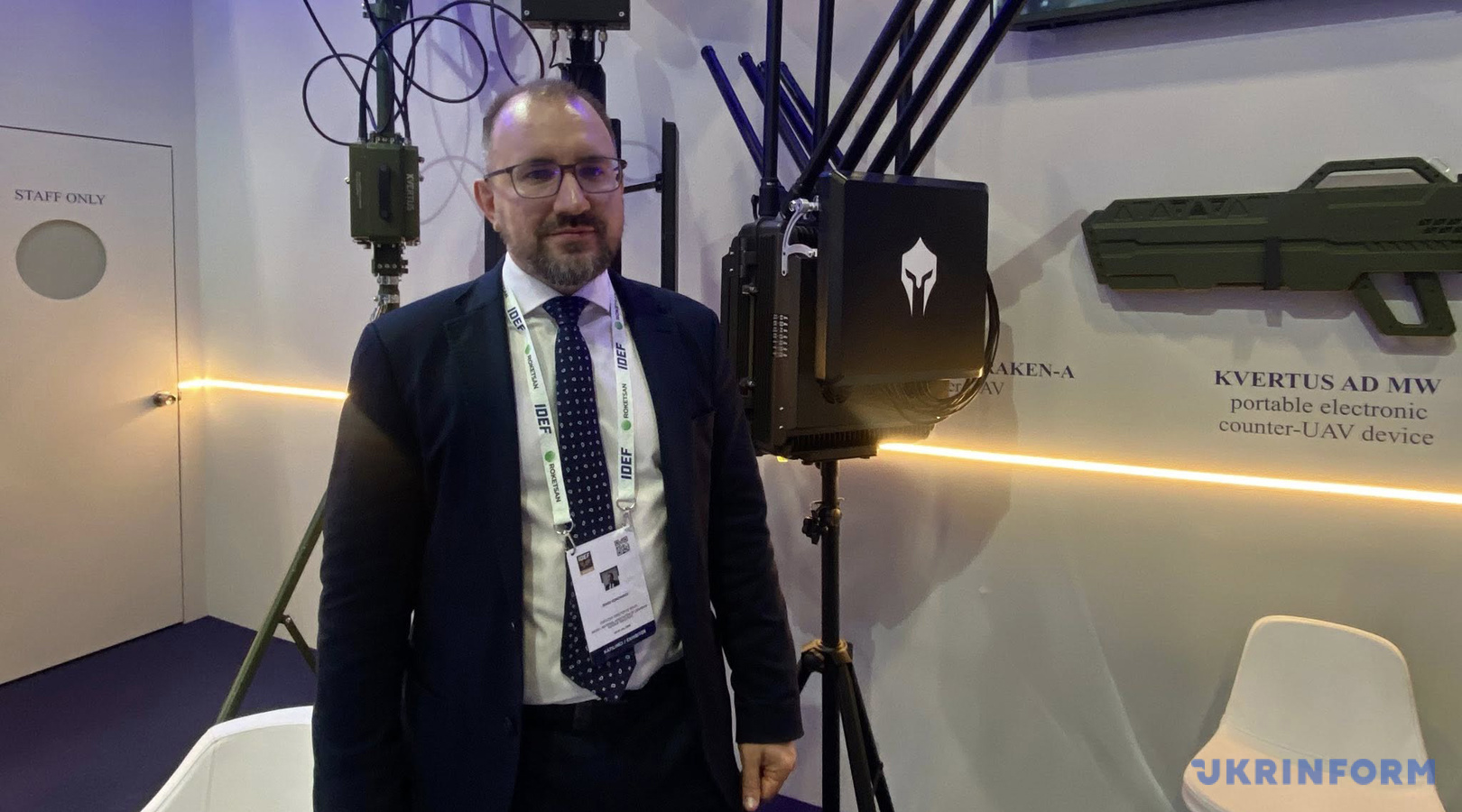
COOPERATION WITH SOUTH KOREA HOLDS GREAT POTENTIAL
– You mentioned Turkey’s accomplishments in building up its defense industrial capacity and the country’s cooperation with Ukraine. What other countries are of interest to Ukraine as potential partners for cooperation?
– We are closely cooperating with the Czech Republic, Germany, and Poland among other European countries. I would really like to see South Korea added to this list. It is an extremely powerful country in the arms market. It, like Ukraine, focuses on high-quality, affordable, reliable and inexpensive products feasible for large-scale production. South Korea executes its defense contracts very quickly, and this is appealing as well. We too have something to offer them.
For geopolitical reasons, our dialogue is not very dynamic, unfortunately. We are expecting that Ukrainian ministries of defense and economy will be more active in communicating with their counterparts. Seoul already provides significant amounts of economic support to Ukraine through monetary and economic programs, but defense industrial cooperation is not actually taking place today. They are waiting for the greenlight from their Ministry of Defense, which cannot be given before a communication channel is established with our government, with our Ministry of Defense. These issues are about military technology, and therefore they are not easy to handle.
UKRAINIAN-MADE ARMS PRODUCTS EXEMPLIFY ECONOMIC EFFICIENCY
– At the latest expo, during one of the panels, a pretty vibrant discussion unfolded among attendees around a question of which is more relevant – quantity or quality — in a modern war? The point was that Russia is attacking Ukraine with large numbers of relatively primitive Shahed drones, while Ukraine is already creating more intelligent weapons capable of effectively counteracting Russian ones. So, what, in your opinion, will prevail – quantity or quality?
– The basis of any such comparison should be the principle of cost effectiveness, economic efficiency. The war Russia is currently waging against Ukraine shows that this war is between economies. A military confrontation is impossible to win with a small amount, but only with high-quality, extremely precise equipment, ammunition, anything. The war waged in the format that Ukraine is waging requires a huge amount of everything. But we should not focus on the cheapest if it does not meet the quality requirements, because we do not need military warehouses to be filled with thousands of drones that are cheap to purchase but are not airworthy. There should be a reasonable balance between cost and performance. And Ukrainian products are a perfect example of cost effectiveness, providing sufficiently high quality at a reasonable price. This is what is called “reasonable” price in English. But this concept is interpreted somewhat differently in Ukraine and in the West. Ukrainian-made weaponry is at least two to three times cheaper to buy. We are limited in terms of profitability, while foreign manufacturers factor the cost of R&D, industrial scaling, risks, etc. Ukrainian manufacturers are more limited in resources, and this gives us the opportunity to be competitive in terms of cost. This holds true for every segment of the defense industry (weapons and military equipment, – ed.). But it’s not always that this race for more affordable prices is beneficial. At a certain point, the result is that more expensive, higher-end components are replaced with cheaper alternatives, which can affect the performance of the finished product. The Ukrainian forces should receive high-quality, reliable products for use, instead of accumulating spare parts in warehouses as “donors”.
Also, unfortunately, state backing for domestic manufacturing remains mostly in words, there are no price preferences provided for Ukrainian manufacturers. Ukrainian-made artillery shells are fully competitive with modern Western-made counterparts, but it’s simply impossible to compete in price with shells manufactured in the 1970s or 1980s. But you can’t build a strategically independent defense industry based on such a “profitable” purchase.
At the same time, high-quality Ukrainian weaponry is still cheaper than Western one. First, because the price specified by partner countries during delivery may be deliberately inflated. The price should not be a decisive factor, because in reality, a small difference in cost can amount to a significant difference in quality.
WEAPONS PERFORMANCE IS EVALUATED WHILE RIGHT ON THE BATTLEFIELD
– Ukraine has end-user feedback right from the front line, so it can quickly assess the latest products…
– That’s what makes us unique. Constant and direct communication channel is established with each unit that uses our products. This communication is particularly dynamic regarding UAVs and electronic warfare equipment. The enemy never sleeps, constantly updating the methods of countering our weapons, and we are doing the same. Many of our companies provide basic training, professional advancement training, and servicing and routine maintenance at their own expense, because it’s often that the state customer does not have the money for this (unless it is included in the product price), and this is a key obstacle to effectiveness and efficiency. Each Ukrainian manufacturer is keen that the product it makes is not only delivered to the military but used efficiently. Today, certain weapons can work well on one particular sector of the front and not work at all on another due to different countermeasures being used by the enemy. Bedsides, different units have different tasks at hand. Feedback is a highly dynamic process that concerns modernization, ways to increase effectiveness and efficiency.
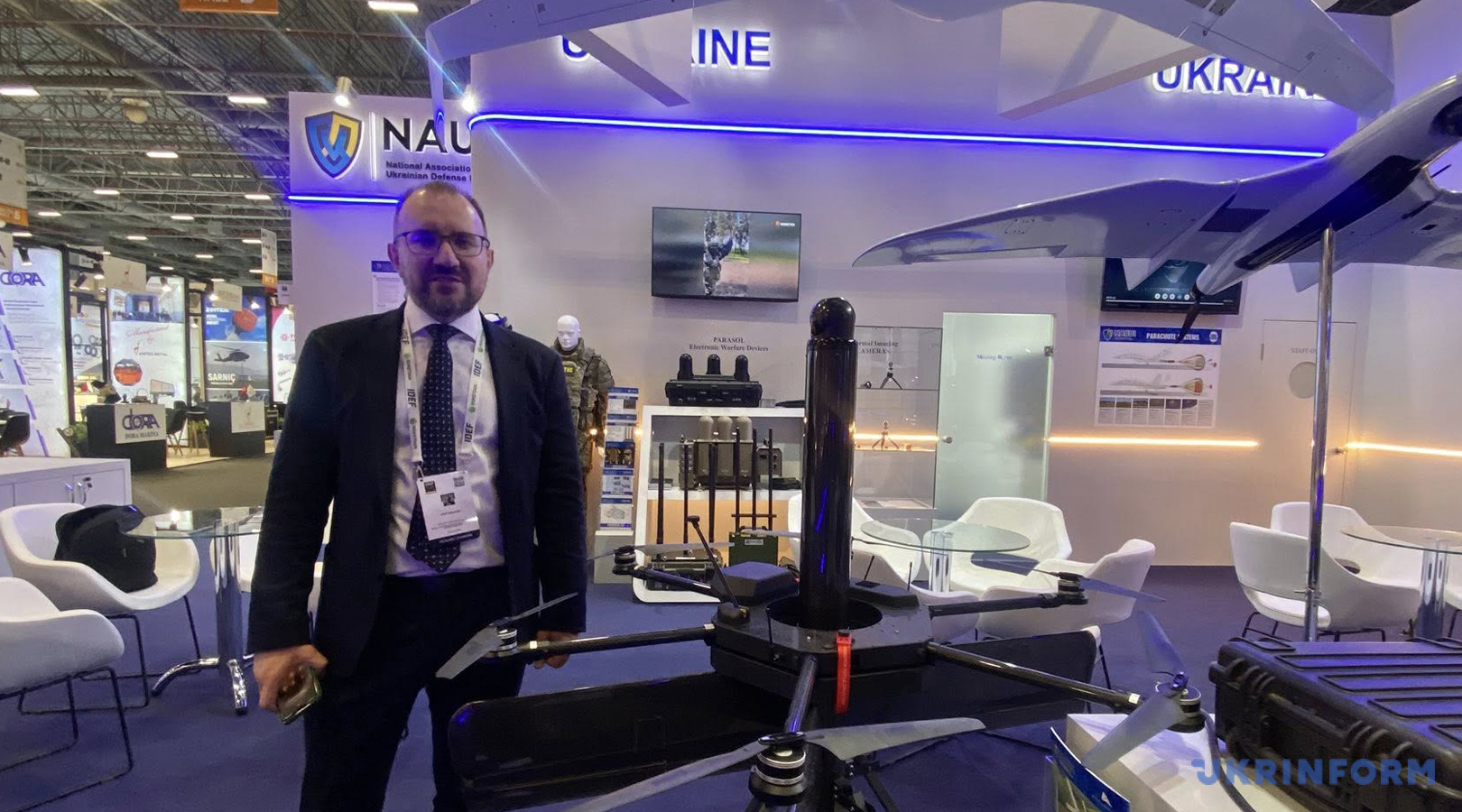
RUSSIA MADE THE WEST BELIEVE THEY DON’T HAVE TO STOCK UP ON WEAPONS, EQUIPMENT, AMMO AND SUPPLIES
– You mentioned the need to stock up on weapons. This trend has continued for the past few years. Previously, on the contrary, the trend was to slow down the arms race, to disarm, because the Cold War was over, after all…
– It was “bubble” information Russia devised to make European countries believe in. They discovered that they had almost nothing to fight with in full-scale war, and what they had in reserve would do for a few weeks of resistance. Before 2022, arms factories were being closed in Europe and the USA; they were going bankrupt and had to change their production specialization to remain afloat. No market – no need. Even after 2014, nothing had changed in Europe’s unified defense doctrine. They did not perceive Russia’s attack on Ukraine as a full-fledged military conflict. The Russian Federation has done huge job to create the illusion that this was not a military conflict between two countries, but something happening inside Ukraine. Some partner countries, primarily those bordering Russia, began to gradually build up their defense capabilities, but not in the amounts necessary in the event of direct aggression.
Then a breakthrough occurred; advanced countries began looking towards affordable, high-quality weapons, because in those countries, defense industry products have always been identified with high-value products. Now they have already saw the value of (relatively) cheap drones and other technologies. Previously, production of 20,000 artillery shells per year was considered completely sufficient. Now everyone understands that there should be many more artillery shells, numbered not in thousands, but in millions. Nowadays, statistics suggests that drones account for up to 70-80% of target hits. Perhaps this may be true, but most likely, this may be indicative of a shortage of long-range artillery shells rather than the effectiveness of drones. Should we have more of them, the proportion could be different.
– So, the arms race will be renewed again, sooner or later, albeit with cheaper weapons?
– Not so much in quantity as in the percentage of successful hits in relation to the number of drones consumed, that is, how much it will cost to engage a target. If, hypothetically, 20 drones worth USD 500 each were used to destroy an enemy tank, then, accordingly, the cost of the defeat is not USD 500, but USD 10,000. This is also important to factor if the tank was completely destroyed, permanently disabled, or damaged (repairable). This is all the economics of war. It must be taken into account.
Ukraine and the Ukrainians are waging a terrible, extraordinary, devastating war that lasts not for three and a half years, but since 2014, with different intensities and involvement of particular types of weapons and military forces. In 2022, a new round, push, stage of this war began, in which significantly more enemy forces were involved than before. The war has been going on for over 10 years now, and, of course, this affects our Armed Forces, the war economy, and the percentage of successful hits. We are tired, but we are holding on and not giving up.
SOONER OF LATER, THE HOT PHASE OF THE WAR WILL PASS, BUT RUSSIA WILL REMAIN A DANGEROUS NEIGHBOR
– Obviously enough, in the war economy, there is a question of war duration. This war is unlikely to end tomorrow, no matter how much we and our partners want to and make efforts to achieve this goal…
– We must expect, both economically and psychologically, that this war is not going to end any time soon. In the long term, we should focus on something else. Sooner or later, this hot phase of the war will end, but Russia is unlikely to disappear tomorrow. And even in the event of a temporary or complete ceasefire, nothing will change in the minds of the Russian population zombified for years about the need to “liberate the fraternal people”, “destroy the Kyiv regime” and suchlike nonsense. The same goes for the Kremlin’s aggressive policy, it will not go away. They only change their minds when a drone flies in, or better yet, several at once.
Unfortunately, many of our partners think that the only thing they have to do is to convince one person who makes the decision to shoot or not to shoot, bracketing the fact that there is the Russian people and there is the dictatorial regime. I doubt that the Russian people and the dictatorial regime are not the same things. Instead, I am convinced that the current Russian dictatorial regime is a product of the Russian people and Russian chauvinism, which they have always had, just like Russian imperialism.
Therefore, we must still be aware of and understand the need to shore up our defense capacity. I hope that, in addition to statements about the need to ramp up domestic production, there will be certain actions and steps taken by the authorities to get the process moving and support this domestic production. This is a complex and long-lasting process. Now everyone needs everything, and very urgently at that. But to build a tank, for example, one needs to have armor steel and armored glass, which cannot be bought like bread or potatoes. A domestic manufacturer needs long-term contracts and an understanding of what to do in a year, two, or five, how much steel or glass to order. We have already evolved somewhat in this process: state customers do not conclude contracts in November-December, as was the case before, but begin concluding them in March-May. And therefore, it should be understood that if someone says that he is able to deliver a million rounds of ammunition tomorrow, just needs the money, he is most likely lying.
The Ukrainian defense industry has the production capacity of USD 30-35 billion each year. We can achieve even more with additional investments and additional workforce. We currently operate at about 30 percent of capacity. So, there is room for growth, something to work on.
Olha Budnyk, Istanbul
Photo via Author

